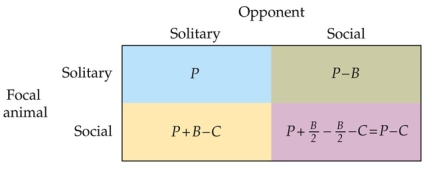Multiple Choice
Refer to the figure. The figure shows a matrix of fitness payoffs for interactions between two behaviorally different types of gulls: those that always fish for themselves and those that sometimes steal fish from others. P stands for the baseline fitness that a gull derives when it fishes for itself. B is the fitness gained by a thief when it steals a fish from a fish-for-self type. C is the fitness cost associated with an attempt to steal a prey.
The figure shows a matrix of fitness payoffs for interactions between two behaviorally different types of gulls: those that always fish for themselves and those that sometimes steal fish from others. P stands for the baseline fitness that a gull derives when it fishes for itself. B is the fitness gained by a thief when it steals a fish from a fish-for-self type. C is the fitness cost associated with an attempt to steal a prey.
What is the significance of the fact that in a population composed entirely of thieves, the average fitness payoff for a thief is P - C, whereas in a population composed entirely of fish-for-self types, the average payoff is P?
A) It tells us that fish-for-self types will become more common over time.
B) It tells us that the spread of a trait depends not on its absolute fitness effect but rather on its fitness effect relative to an alternative trait.
C) It tells us that the thief phenotype is an evolutionarily maladaptive trait.
D) It tells us that the thief phenotype is costly for the population as a whole.
Correct Answer:

Verified
Correct Answer:
Verified
Q15: In order to test the selfish herd
Q16: Observation: You observe "shaky leaf walking" in
Q17: A conditional strategy is unquestionably an adaptation
Q18: Several hundred male bees will sometimes gather
Q19: Caro (1986) presented several hypotheses for stotting
Q20: A certain fish-eating hawk that lives by
Q21: A seed-eating bird forages in groups with
Q22: Smaller seed-eating birds select smaller seeds than
Q24: Refer to the figure.<br><img src="https://d2lvgg3v3hfg70.cloudfront.net/TBO1022/.jpg" alt="Refer to
Q25: Observation: You observe "shaky leaf walking" in